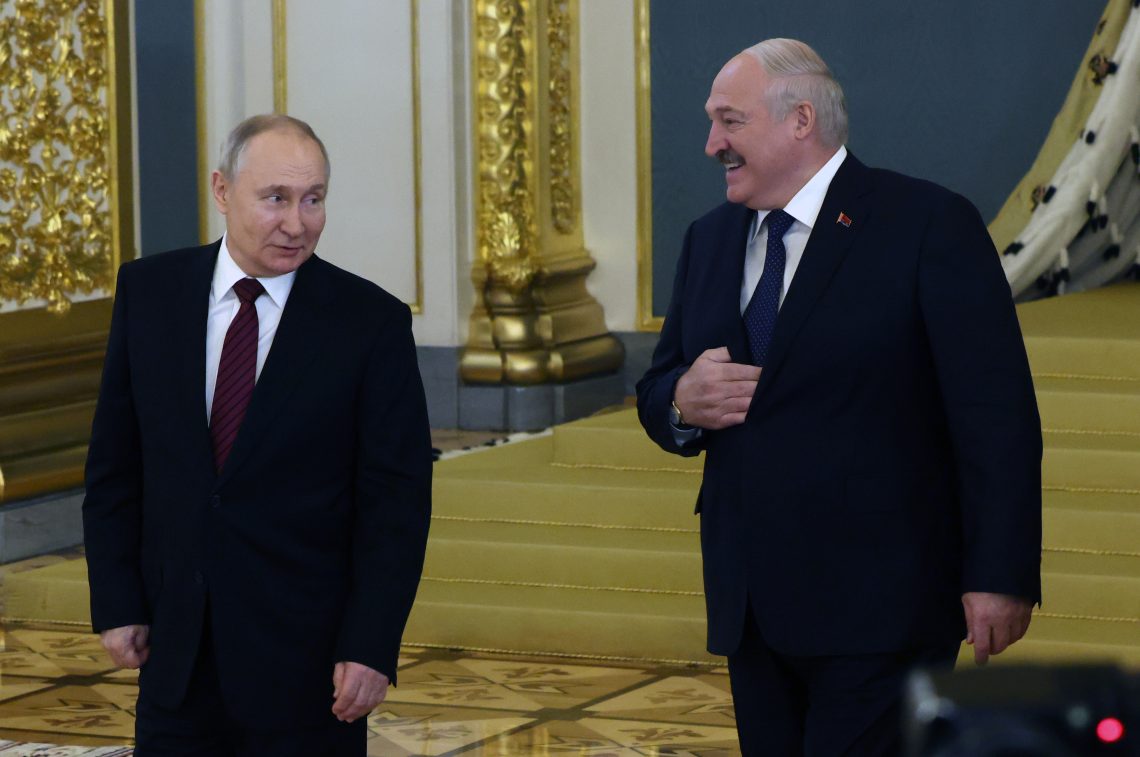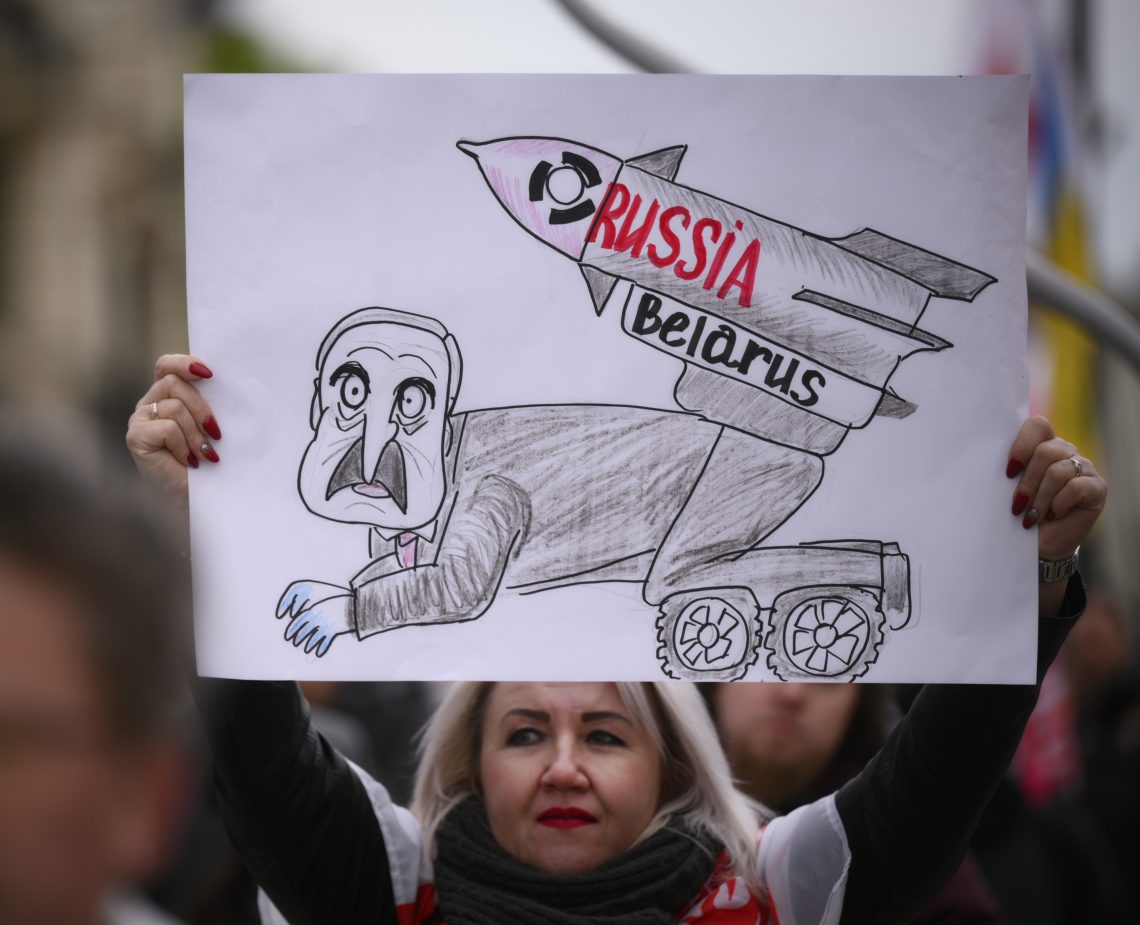Russia’s strategy in sending tactical nuclear weapons to Belarus
The Kremlin’s move may be more saber-rattling, but it also heightens the security concerns of NATO members.

In a nutshell
- The chances of Russia using tactical nuclear weapons are assessed as low
- The Kremlin may, however, be searching for a dramatic move to defeat Ukraine
- Belarus is likely to face consequences from the West for hosting such arms
Russia’s unprovoked war on Ukraine is not going as Moscow envisioned it would back in February 2022 when it launched its full-scale invasion. After 18 months, the largest land war in Europe in this century slogs on with no end in sight.
Driven by nationalism and a desire for a lasting legacy, Russian President Vladimir Putin appears desperate as the Ukrainian counteroffensive progresses. With political and economic pressures mounting at home over the conflict’s catastrophic developments and the imposition of economic sanctions from abroad, many observers suspect President Putin may be looking for a dramatic move to bring victory home.
An ongoing concern in political and policy circles, especially in Europe, the United States and even China, is that Russia might turn to tactical (also known as battlefield, low-yield or non-strategic) nuclear weapons to achieve that objective. While the chance of this happening is currently assessed as low, the possibility of Mr. Putin detonating one or more weapons from his non-strategic nuclear weapons (NSNWs) arsenal is not zero.
Adding to already high anxiety over the conflict and how it might unfold, Moscow reportedly deployed some of these weapons to neighboring Belarus this summer.
More by Peter Brookes
Ukraine’s long path to victory and NATO
China’s nuclear weapons buildup
The potential for a biolab-origin pandemic
Talking tactical nukes
While the definition of an NSNW is imprecise, these armaments have shorter ranges and lower explosive yields than strategic nuclear weapons associated with long-range, high-yield intercontinental ballistic missiles (ICBMs).
NSNWs usually have an explosive yield in the one to 100 kiloton (KT) range (one KT equals 1,000 tons of the explosive trinitrotoluene or TNT). They are designed for use on the battlefield against substantial military units or other suitable political or military objectives. In contrast, strategic nuclear weapons, purposed to destroy large cities or high-value military or political targets, pack a 100-plus KT punch. For a rough comparison, the two U.S. atomic bombs that hit Japan in 1945 were in the 15-20 KT range.
Unconstrained by any international arms control agreement, such as the New Strategic Arms Reduction Treaty (New START) that limits Russian and American strategic weapons, it is estimated that Russia might have as many as 2,000 NSNWs. In comparison, the U.S./NATO has only about 200 tactical nuclear weapons, with 100 of them based in Europe and 100 remaining in the U.S. In other words, Russia has at least a 10 to 1 advantage over NATO in this weapon category.
Ukraine has no nuclear weapons to deter or respond to Russian aggression. In 1994, citing its inability to circumvent Russian launch codes, it rid itself of all the Soviet-era atomic weapons based on its territory during the Cold War by reaching an understanding for destroying some and repatriating the rest of them to the Russian Federation. Ukraine is a nonnuclear state now and a party to the Treaty on the Non-Proliferation of Nuclear Weapons (NPT).
On the battlefield, the NSNWs can be delivered to a target in several ways, including by missiles, aircraft and artillery. Russia can make use of them or simply threaten their use. And indeed, there has already been no shortage of Russian veiled threats on this account since the war began. The purpose of these threats – whether Russia is bluffing or not – is to get Kyiv and its NATO supporters to back down on the battlefield without Moscow having to detonate an NSNW in what would be considered a significant escalation to the conflict.
Another way for the Kremlin to signal its frustration with how the conflict is going is to explode one of these weapons in an underground test in Russia. Seismic monitors around the globe would detect the blast – and Moscow’s menacing message would be transmitted loud and clear. The Russian military could also explode a tactical nuke over uninhabited territory in the Arctic. Of course, doing so would risk the spread of radioactive fallout, including potentially into Russia, depending on wind patterns.
Lastly, Moscow could use these superweapons against the Ukrainian military or the Ukrainian people. Detonating just one device could have a profound psychological impact and change the war’s course. Russia would hope that its use of one NSNW, with the prospect of more to come, would drive Ukraine to the negotiating table on Moscow’s terms, give serious pause to Kyiv’s Western supporters and bring the bloody war to a quick conclusion.
But even with these options at hand, Russia has found another way to threaten Ukraine and try to intimidate its NATO backers. It is by playing a less obvious nuclear card.

Belarus-bound bombs
That card is news that Russia has transferred some of its nuclear weapons to Belarus, a former Soviet republic. Like Ukraine, Belarus hosted Soviet nuclear weapons during the Cold War, but now is seen mainly as a Putin protectorate.
The Belarus-based NSNWs could be delivered to their targets by Russian-built, nuclear-capable weapon systems such as the Iskander short-range ballistic missile or the Soviet-era Su-25 attack aircraft. Now, there is little doubt that the transfer has occurred.
The Russian NSNWs will almost assuredly remain under President Putin’s operational control while in Belarus, despite what Belarusian President Alexander Lukashenko says. Mr. Putin is basing these Russian weapons there, not giving them to President Lukashenko, which would arguably violate Russian obligations under the NPT.
Russia’s likely reasoning
There is more than one possible reason why Russia decided to deploy nuclear weapons outside Russia for the first time since the end of the Cold War.
The deployment shows that Russia is not alone in this fight in Ukraine. Like Ukraine, it has friends and allies, too. Of course, Minsk must understand that the presence of these Russian weapons has consequences for Belarus. The move is also a Russian public relations pushback to NATO’s offers of alliance membership to Sweden and Finland. Both Nordic neighbors possess advanced militaries, and Finland has an 800-plus mile border with Russia, increasing the Kremlin’s defense perimeter and exposure to NATO forces.
The deployment of these NSNWs outside of Russia to Belarus also seeks to balance NATO’s stationing of U.S. tactical nuclear weapons in Europe.
The development, Moscow hopes, should also get the rapt attention of those in the West, especially among politicians, policymakers, academics and activists, who are concerned about security matters, the spread of weapons of mass destruction and future arms control prospects involving Washington and Moscow.
In addition, Belarus has a long border with Ukraine. An expanding Russian military presence in Belarus could make the border an even more significant front for Kyiv to worry about and defend against, potentially having to divert its forces from the pitched battles in the south and the east.
And while Russia is believed to have Iskander nuclear-capable missiles in Kaliningrad Oblast, its exclave located between Poland and Lithuania, this deployment to Belarus expands numerically and broadens geographically the Russian nuclear threat against NATO.
Moving more of the short-range nuclear weapons closer to NATO – Belarus borders NATO members Poland, Lithuania and Latvia – raises, at a minimum, the perception of the Russian threat and could serve to weaken the alliance’s support for Ukraine, especially beyond NATO’s frontline states.
Of course, the question is whether these Russian battlefield nuclear weapons will stay in Belarus or eventually be returned to Russia.
Scenarios
Weapons return to Russia
It is possible that Russia’s deployment of NSNWs to Belarus is temporary and that Moscow will eventually recall its nuclear forces. This period could conclude once the Russian nuclear threats have achieved a desired military or political effect, such as undermining NATO’s political and military support for Kyiv. The Kremlin could also shuttle the weapons back and forth between Belarus and Russia in a high-stakes “shell game” to precipitously raise anxiety in European and American political and policy communities, especially in Poland and the Baltics. Moscow could also recall the weapons as a gesture of goodwill toward NATO and Western arms control advocates, as a confidence- and security-building measure to lower tensions with Ukraine and NATO, as an element of a future arms control agreement or as part of a cease-fire or peace agreement with Ukraine. Lastly, a change in the leadership of the Russian regime could also bring the return of the weapons to Russia. Despite these possibilities, this scenario is the less likely of the two.
Weapons stay in Belarus
The movement of Russian NSNWs to Belarus is a significant development in the Ukraine war, European security and nuclear non-proliferation. It is a weighty decision on the part of the Kremlin to move weapons of mass destruction to another country, even controlled by a client regime. While President Putin is in power, it is unlikely that the decision will be reversed – not easily, at least. For the Kremlin, the deployment to Belarus is morally and militarily equivalent to the presence of American NSNWs in Europe. Moreover, it provides a political-military counterweight to NATO expansion to Sweden and Finland.
The transfer of NSNWs to Belarus will also serve as a bargaining chip for Russia in any future negotiations, especially on arms control, European security and the war in Ukraine.
The presence of such weapons and Russian forces on Belarusian territory will raise concerns over an additional front for Ukraine and increases the NATO defense perimeter in Eastern Europe and the Baltics. It will also raise the alarming prospect that President Putin may intend to forge a land bridge to Kaliningrad from Belarus through the 60-mile Suwalki Gap between Poland and Lithuania, repeating the precedent of seeking Russia's land access to Crimea through Ukraine. The movement will also give Mr. Putin additional leverage with President Lukashenko. All this, regrettably for Minsk, gives NATO a reason to target Belarus in a conflict. But it also potentially augments Belarusian security by symbolically adding a nuclear deterrent dimension to Belarus’ relatively weak conventional defense posture. Though a member of the Russia-led Central Security Treaty Organization, it also creates a deeper political-military relationship with Moscow. As a result of these factors, this is the most likely scenario.









